Repair Topics
Repairing Water Heater Anode Rods
 Why is a water heater anode rod important to you? This is the quiet dutiful soldier of your hot water tank. Often called a 'sacrificial anode' it keeps your hot water tank from rusting. It is quiet in the sense that there is no obvious sign that it has gone bad.
Why is a water heater anode rod important to you? This is the quiet dutiful soldier of your hot water tank. Often called a 'sacrificial anode' it keeps your hot water tank from rusting. It is quiet in the sense that there is no obvious sign that it has gone bad.
If you need an anode rod there are a couple of concerns, first of all, what type to you want? See the articles, 'Types of Metal for Anode Rods' and 'Anode Rod Installation Types' to find out what the choices are and reasons why you have choices. Getting the old one out can be a problem, see the information below for what you need to do.
Of course you will need a new anode rod, the article 'Purchasing an Anode Rod' will explain where to look for one at.
These rods are usually made of aluminum or magnesium. The latter being the better of the two and more expensive. Explaining how and why an anode rod works is complicated and pretty dull. We will skip that discussion. Simply put, the anode rod is more reactive than the steel in your hot water tank. Therefore, it will corrode or 'sacrifice' itself in place of the steel in the tank.
When the anode rod disintegrates the water will start reacting with the steel and your tank will rust. The expected life of an anode rod is about five years. The hardness of the water and temperature will affect the life span. Softened water will cause an anode rod to wear out in as little as six months. See what you need to do to check and replace your anode rod by reading on.
Hot Water Heater Anode Rod - The Issues
What Can You Save? - Access to the hot water tank is a problem. The anode rods are long and get very brittle over time. This makes taking them out a little troublesome. The going rate for an anode replacement is $200 to $300. The part will cost between $25 and $40. Your savings could be as high as $260 if you do it yourself.
How Hard Could It Be? - Water heater anode rods are not the easiest thing to change. Plan on a little patience and effort. These repairs will have a Difficulty Level of: A Bit of Work. These repairs require a Skill Level of: Handyman. For and explanation of the terms in this section, see 'How to Use This Site'.
Check the Simple Things! - Sorry, nothing simple with this one. Just getting it out to inspect it involves some work.
What Can Go Wrong? - An aluminum hot water heater anode rod can swell and split. This may make hard or even impossible to get out without breaking it. It will rattle around in the bottom of the tank if it breaks. When you have low head room, you will have to bend them it. They can be quite brittle, again, breaking it is a problem.
Removing a Water Heater Anode Rod
Removing an anode rod can be a tough job if the water tank is old and the connection has corroded.
For an electric hot water heater the first thing you want to do is shut off the power. On a gas hot water heater turn off the gas. Close the cold water inlet at the top. Run some hot water and check the pipes if you are not sure. Open a hot water valve in a sink near the hot water tank to relieve any latent pressure.
Use a socket wrench or box end wrench to remove a hex head anode. It should be an 1 1/16" wrench. It is a good idea to spray some penetrating oil on the nut. Loosen the nut to remove the anode rod, it is attached to the nut. This could be tough, you may need a breaker bar.
For a full size hot water tank, the anode rod might be pretty long. Possibly forty inches or more. Do you have enough clearance to get it out? No, then you will have to bend it or cut it to get it out. This is the tricky part. Pull it up as far as you can. Put the vice grips on it at the top of the tank. You don't want it to break off and fall into the tank. Try bending it. Will it bend? Yes, then good bend it and pull out another section. Reset the vice grips and bend it again if you need to. Is this fun or what?
Is it too brittle? It might be better to cut it with a hack saw. Make sure you secure it with the vice grips. Remember, you don't want pieces falling into the tank. Cut it and pull more out and cut it again if you need to.
The combination anode will come out in a similar way. The difference is that you need to use the pipe wrenches to take it out. There should be a union above the tank. Loosen the union first. Always use two wrenches to take apart plumbing fittings. After the union is free you can loosen the nipple going into the top of the tank. You may have clearance issues, follow the instructions above for cutting and bending an anode.
Installing a Water Heater Anode Rod
The method for installing a water heater anode rod will vary slightly depending on the type you have. See the articles 'Purchasing a Water Heater Anode Rod' and 'Types of Water Heater Anode Rods' for information on getting the right one.
Installing a Straight Anode Rod
A standard straight anode rod will screw into the 3/4" opening where the old one came out. You can use some teflon tape or pipe dope on the threads. The metal will still make contact even if you use something on the threads.
The biggest challenge with a straight anode rod is having enough clearance to get it in. If your water heater is in the basement or a closet and you have a full height ceiling, you will probably be all right. A lowered ceiling of any kind may give you a problem. A standard anode rod is around 40", so you need that much clear area above the water heater.
Once you have started the anode rod into the threads, tighten it down with a socket wrench. Turn the water on and check for leaks.
Installing a Flexible Anode Rod
A flexible anode rod will have multiple spots that it can be bent at. Depending on the amount of clearance that you have, you will use one or more of the bends. You will want to straighten the flexible rod as you put it into the tank.
Remember you have to turn the nut back into place, you don't want the anode rod twisted like a pretzel inside of the tank. It does not need to be perfectly straight, but somewhat straight is best.
Use some pipe dope or teflon tape on the threads and tighten the rod into place.
Installing a Hot Water Inlet Anode Rod
This type of anode rod is installed at the hot water outlet pipe. The section of pipe between the outlet and the union in the line will need to be removed. If you are replacing the same type, you had to remove this section to get the old one out.
When converting your hot water tank to this style, you may have to modify the length of the pipe between the outlet and the union. Getting a flexible connection is the best approach.
The anode rod screws into the outlet for the hot water. Then you install the pipe between the outlet and the union. The last thing you would do is tighten the union. Use some pipe dope or teflon tape on the connections. For this connection you will need two pipe wrenches.
Starting Up the Water Heater
After the anode rod is in you have to close any valves you opened and turn the water back on. Check for leaks and that is it. This hot water heater anode rod project is history.
For and elecric water heater turn the breaker back on. A gas water heater will need the gas valve turned to on and the pilot light lit.
Summary
Wow, that was a little bit of work. I wish I could say that 'I hope it was easy', but I know it wasn't. This is a bigger plumbing repair. You can comfort yourself with the knowledge that you are prolonging the life of your hot water tank.
Replacing your hot water tank is an even bigger job. To be honest, hauling a old water heater away is a big job. Completely replacing your water heater, well, you will want to get some rest. Your hot water heater anode rod should be good for another five years.
Troubleshooting Hot Water Heaters
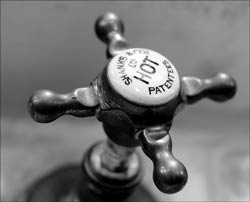 Troubleshooting hot water heaters is needed when you start having trouble with your water heater. There are numerous problems that you may be having. Usually the one that gets your attention is No Hot Water or Not Enough Hot Water. When this happens, cool or cold showers start to be a real problem. What can you do? Is this something you can take care of? This depends largely on the problem you are having.
Troubleshooting hot water heaters is needed when you start having trouble with your water heater. There are numerous problems that you may be having. Usually the one that gets your attention is No Hot Water or Not Enough Hot Water. When this happens, cool or cold showers start to be a real problem. What can you do? Is this something you can take care of? This depends largely on the problem you are having.
To make things more complicated there are different types of hot water heaters. In homes that have natural gas you will likely have a gas hot water tank. Gas water heaters heat the water by burning natural or LP gas. Burner issues, pilot light issues and the famous thermocouple are among the things you might be faced with.
Electric hot water heaters use electricity to heat the water. A heavy duty electrical circuit is installed for this purpose. Heating elements and thermostats are the leading causes of problems.
Troubleshooting Hot Water Heaters - Issues Involved
How much can you save? That is a question that has a broad answer. A service call may start out at $100. Being sold a new hot water heater could run as high as $3,500 for a top of the line high efficiency model. Most parts for a hot water heater are less than $25.
For an electric water heater checking the breaker would be the place to start. The thermostats also have reset buttons on them. A gas hot water heater needs to have the pilot light checked. Has it gone out for some reason.
Electric water heaters have strong current that heats the water. Make sure the power is off before even attempting a test. Gas hot water heaters use natural or LP gas and gas can explode. Make sure the gas is off before you take anything apart. Both types have very hot water in them and burns or scalding are possible. Being without a hot water heater is a serious inconvenience. Your family will likely be unhappy.
Troubleshooting Hot Water Heaters - Finding Information
Troubleshooting water heaters has to split into two categories at this point. In order to solve your water heater problem you need to veer off into one of two directions. You either have an electric water heater or a gas one. The problems and things to look for are different. There is some general information about each type. In addition there is a link to the troubleshooting articles for each type.
Are you looking for some information on tankless water heaters? Try Plumbing Help - Tankless Water Heaters for some information on this type of unit.
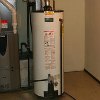 Gas Hot Water Heater Troubleshooting
Gas Hot Water Heater Troubleshooting
Gas hot water heaters are an ecomomical way to heat water. However, they use a combustible fuel and have safety features built into them to prevent explosions. With that said, it sometimes these safety features that prevent the unit from working.
Troubleshooting water heaters that use natural gas will often focus on the gas valve and burner assembly. This article uses descriptive language to help you to narrow down your problem.
The water heater gas valve is able to interpret this electrical current and tell whether or not the pilot light is lit. A defective thermocouple will not send the proper signal. The gas valve will not allow gas to go to he pilot light or burner if it does not get the right signal.
The thermocouple is not the only problem you can have. However it is often the culprit when the pilot light or the burner will not stay lit. The above link takes you to an article that discusses majority of possible problems you could have with your gas water heater.
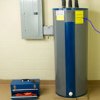 Electric Hot Water Heater Troubleshooting
Electric Hot Water Heater Troubleshooting
An electric water heater normally uses a 230 volt 30 amp circuit to operate. This is some serious electricity. Extra care an caution needs to be exercised when working on this type of unit. If you uncomfortable around electricity or unwilling to take precautions, it may be better to call a professional. Willing to be careful? Then you probably can fix it.
For electric heater, water heater troubleshooting involves dealing with electrical devices. An important one is the heating element. These can burn out over time. A burned out element can cause you to have 'no hot water' or 'very little hot water'. Elements can be changed but there is some work involved.
Another trouble maker is the thermostats. Unlike a gas water heater and electric one has two. The upper thermostat controls the lower one. So any issues with the upper thermostat or element and you will have 'no hot water'. Testing is involved in troubleshooting water heaters that are electric. Don't be afraid, the tests are pretty simple.
Of course there are other problems with electric water heaters. The above link takes you to an article that discusses all of them. Follow the link to get the information you need.
Problems Common to All Water Heaters
 Water Heater Sediment Build Up
Water Heater Sediment Build Up
Sediment can build up in the bottom of your hot water tank over time. This affects the amount of hot water that the tank can produce. In addition, it can cause damage to other parts of the water heater.
This is especially true of electric water heaters. The lower elements of electric hot water heaters can burn out due to sediment. There are steps you can take to remove the sediment. Learn what they are by following this link.
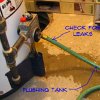 Flushing a Hot Water Tank
Flushing a Hot Water Tank
Sediment build up in a hot water tank is a bad thing at several levels. First, it reduces the amount of available hot water. If you have twenty percent of your tank filled with sediment, you will have twenty percent less hot water to use. A related problem is that, you will have to pay to keep the sediment hot. This is a waste of energy and money.
Electric water heaters can be further damaged by sediment build up. Heating elements can be damaged from sediment build up. This will cause the lower heating element to fail, dramatically reducing the amount of hot water the tank can produce.
Regular flushing of the tank can prevent or eliminate problems.
This is the process that will remove the sediment inside your hot water tank. It is a bit of work and you will need to take precautions to keep from making too much of a mess. A garden hose and a pair of pliers is all you need. Click on the link above to get to the information.
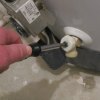 Fixing a Leaking Hot Water Heater
Fixing a Leaking Hot Water Heater
How serious is it when a hot water heater is leaking? That depends a lot on where it is leaking and how much. Some things can be tightened to stop the leaks.
When the tank itself starts to leak, it means that the water heater needs to be replaced.
Find out if you need to look through your papers for the warranty. See if this is something you can fix. Click this link to get the good or not so good news.
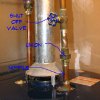 Repairing a Water Heater Dip Tube
Repairing a Water Heater Dip Tube
What's a dip tube anyway? Believe it or not, it is an important feature of your hot water tank. Find out what can go wrong with this part and what you need to do to fix it.
Just take my word for it, it is important. The amount of hot water you have will be affected by it, when it is broken. Follow this link for information.
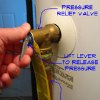 Repairing a Water Heater Pressure Relief Valve
Repairing a Water Heater Pressure Relief Valve
A pressure and temperature relief valve is a safety feature on a water heater. When pressure builds up, to an unsafe level, inside your hot water tank, this valve releases. A defective valve will release when the pressure is still within safe limits. How to you know when it is bad? How hard is it to fix?
Click on the link above to find answers to these questions. Can you replace this valve if you need to? How hard is it? More questions that this article answers.
Troubleshooting Hot Water Heaters - Summary
Water heaters are an important feature in your home. They are sorely missed when the don't work. Finding and solving the problem quickly is important. The links above should have pointed you in the proper direction. Hopefully you will be able to track down your problem and fix it.
After your troubleshooting water heaters project is complete you may decide to call a professional. Knowing what the problem is, will save you money when you talk to them. When you understand the problem you will not be sold on things you don't need.
Types of Water Shut Off Valves
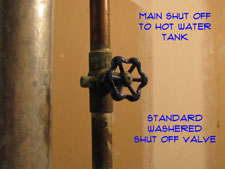 The type of water shut off valve that you have will determine what could be wrong with it and what methods you may have to employ to fix it. Leaks and a failure to turn off are the most common problems.
The type of water shut off valve that you have will determine what could be wrong with it and what methods you may have to employ to fix it. Leaks and a failure to turn off are the most common problems.
Do you have a different problem? See 'Plumbing Repair' for a complete listing of all the plumbing topics.
The function is the same for all of the valves. When they are open the water flows through. Closed, the water stops flowing. Bad seats or washers can cause this functionality to fail.
Ball Valves
The best and least problematic valves are lever ball valves. Generally you can recognize these by a straight lever instead of a round handle. The other main feature is that they only turn ninety degrees or one quarter turn. Instead of using a washer, these valves have a machined ball inside that positively shuts the water off. These valves are less likely to leak and give you problems over the long haul. However, the down side is that they cost a lot more and plumbers are not inclined to use them on new installations.
One quarter turn 'ball' type water shut off valves for residential fixtures have gotten popular in recent years and the cost has come down considerably. If you do need to replace a chrome shut off valve in your home, you should consider this type.
Gate Valves
Gate valves are not common in homes. Like the ball valve they have a machined inner mechanism. The 'gate' that moves down to shut off the water is controlled by a handle that turns similar to a normal valve. Gate valves are usually larger than a normal valve. This type also costs a lot more and is seldom used. They are more often found in commercial or industrial applications.
Washered Valves
Washered type water shut off valves are the ones you find most often. They come in different sizes and shapes but the general way they work is the same. The washer closes down on a metal seat via the handle and shuts the water off. The problem is that the washers wear out and don't shut off properly.
It is not uncommon to find jars full of various sized washers in garages and basements around the country. Washers come in numerous sizes. Replacing a washer with the wrong sized one will not have good results. Washered valves are the cheapest to purchase and they have the most problems.
Fixture Shut Off Valves
Most of you household fixtures, such as sinks and toilets have water shut off valves located near or below the fixture. Look under your kitchen sink and you will likely find two shut off valves located there.
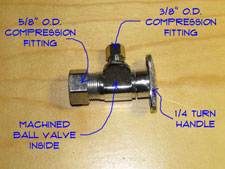 These valves are usually chrome plated and also act as a reducer in the pipe size. Often they reduce the 1/2" water lines to 3/8" lines that attach to the individual fixtures.
These valves are usually chrome plated and also act as a reducer in the pipe size. Often they reduce the 1/2" water lines to 3/8" lines that attach to the individual fixtures.
No matter which style you have you will need to shut the water off to work on the valve. Quarter turn ball valves are a much better choice if you decide to replace the valve. The shut off action is much more positive. In addition the machined ball is less prone to problems in the future.
To replace this valve remove the old one, (assuming you have a threaded or compression fitting) and install a new one. Use the old nut on the new comprssion valve, since it is unlikely that you have enough extra pipe cut off the brass ferrule. Use pipe dope on the threaded fittings. Pipe dope is not needed for a compression fitting.
Stuck with a soldered valve? You probably want to try replacing the washer and tightening the nuts on the valve. Soldering in an existing bathroom is not a great idea.
Outdoor Valves
Outdoor water shut off valves are modified forms of a washered valve. Frost free valves have a long rod on the handle that closes a washer deep inside the wall where freezing is eliminated.
Fixing Water Shut Off Valves
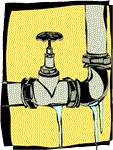 Most homes have many water shut off valves. These valves have water going through them and any time you have water you can have problems.
Most homes have many water shut off valves. These valves have water going through them and any time you have water you can have problems.
There are (3) Topics associated with this repair. (1) There are 'Different Types of Shut Off Valves', knowing what type you have will aid in fixing it.(2) A large percentage of valves have washers in them. 'Repairing Washered Shut Off Valves' covers this topic. (3) Getting a 'Leaking Shut Off Valves' to stop can be a challenge. See this article for information.
The type of water shut off valve that you have can determine how big of a problem you might have. Some valves rarely give you problems. The problem is that these valves are more expensive and are often not used in residential construction.
Can you repair leaking or troublesome valves yourself? The answer would be yes most of the time. You need to be able to shut off the water before you work on a valve and many times you need the right washers for the repair.
Water Shut Off Valves - The Issues
What Can You Save? - Replacing a washer in a valve should be a service call, $50 to $75. Replacing the entire valve is a bit more work, maybe $100 to $150. The problem is that a leaking valve is a great opportunity for a plumber to sell you some additional work. He may point out other problems with your plumbing. Whether or not you have real problems could be debated. His salesmanship may wind up costing you a lot more.
How Hard Could It Be? - Repairing water shut off valves does involve a little work and may make some mess. These repairs will have a Difficulty Level of: A Bit of Work. These repairs require a Skill Level of: Handyman. For and explanation of the terms in this section, see 'How to Use This Site'.
Check the Simple Things! - A valve that is leaking around the stem may not be shut off all the way. Try tightening the handle. The nut the holds the handle assembly in place may be loose, try tightening here before you assume the washer is bad.
What Can Go Wrong? - Water, that's what can go wrong. Messing with an old valve may make the situation worse. A small leak may become a big leak. Getting a valve apart and not having the right washer to fix it would be another problem. You may have to shut down a major portion or all the water to your house to work on a valve. Making sure you can see the project through to completion is a good idea.
Troubleshooting Water Shut Off Valves
The article 'Types of Water Shut Off Valves' provided a description of the common types of valves you might have in your home.
Valves with washers in them are the most common. The article 'Fixing Washered Water Shut Off Valves' discusses the steps to fix them.
Repairing 'Leaking Shut Off Valves' was the topic of the last segment in this series.
Summary
How tough was your water shut off valve problem? Were you able to just tighten one of the nuts and stop a leak? That was not too hard at all. Or did you have to replace a washer? This is a little more work. Shutting the water off, finding the right washer and then actually changing it. Still if you had a washer it may have only been fifteen minutes.
Worst case, you had to replace the valve. For valves on fixtures this is usually not too hard. Replacing these valves with a ball valve will mean you are not likely to have a problem again any time soon.
Gas Stove Troubleshooting Guide
If you own a gas powered range, you need a gas stove troubleshooting guide to assist you in diagnosing problems with your appliance so that you can repair it. This one covers the most common troubles and likely causes.
Why can I not get the pilot light to come on or it goes out quickly when I do?
The opening for your pilot light may be dirty, reducing the amount of gas that flows to it.
In some cases, the amount of gas may be insufficient to keep it lit due to being adjusted too low.
If the room has high air flow from open windows or your heating and cooling system, the pilot light may get blown out from it.
Why can't I get the burner to light?
It is possible that your pilot light is not lit, which will prevent the burners from lighting when you turn them on.
The holes on the burner may be clogged from cleaning it or food spills that were not properly wiped down.
In the case of a stove with an electric ignitor, you may have electrical issues. The unit may have become unplugged from the wall.
Other possible reasons an electrical ignitor is malfunctioning could be that the outlet is not working. You may have a blown fuse or a tripped circuit. Additionally, the ignitor may not be working anymore.
Why is the flame low, even when I adjust the setting to high?
This might be caused by the openings in your burner being caked up with food or cleaning debris.
An insufficient amount of gas or air reaching the burner is another reason that this can happen. The hose delivering gas to the burner may be dirty or your air shutter might be improperly adjusted.
Why is my gas burner making noise when I turn it on?
Loud sounds from the burner are an indicator of air or gas flow troubles. The air shutter may be the culprit or you could have troubles in the lines themselves.
Why do I smell gas coming from the range?
This might be due to an unlit pilot flame. If there is no fire, the unit will continue to release small amounts of gas into the air.
One or more of your burners may not be shut off completely even though the flame is out. If the unit also has an oven, the gas may be coming from there as well.
If your gas lines have even a small amount of damage, the gas will leak into your kitchen or where the damage is located. No matter the cause, this is a very serious matter that needs to be repaired immediately.
Why do I hear a clicking sound when my gas stove is on?
This is normal in most gas stoves and is due to the appliance making natural adjustments.
These gas stove troubleshooting questions are the most common. Determine the cause of your problem so that you can repair it.


